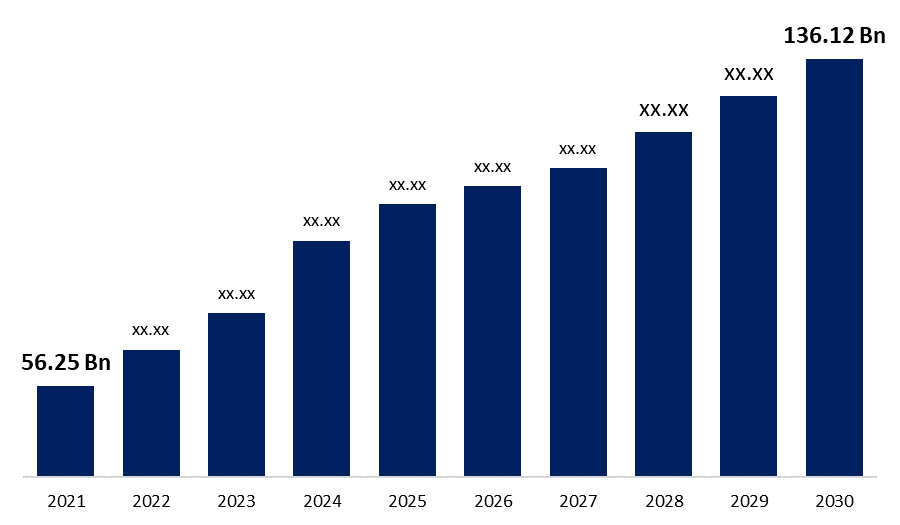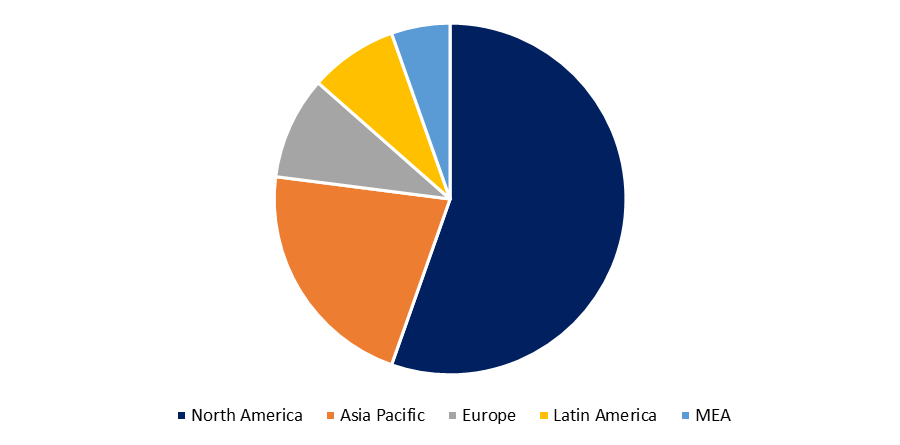Global Last Mile Delivery For E-Commerce Market Size, Share & Trends, COVID-19 Impact Analysis Report, By Type (Electronics, Clothing, Luxury, Health Products, and Domestic Appliances), By Business Model (Business to Business (B2B), Business to Consumer (B2C), Consumer to Consumer (C2C), Consumer to Business (C2B), and Business to Government (B2G)), By Delivery (Deferred Delivery, Time-Definite Delivery, Same Day Delivery, and Instant Delivery), and By Region (North America, Europe, Asia-Pacific, Latin America, and the Middle East and Africa), Analysis and Forecast 2021 - 2030
Industry: Consumer GoodsLAST MILE DELIVERY FOR E-COMMERCE MARKET: OVERVIEW
The Global Last Mile Delivery for E-Commerce Market Size was valued at USD 56.25 billion in 2021 and is expected to reach USD 136.12 billion by 2030, growing at a CAGR of 8.13 % during 2021-2030. Last Mile Delivery for E-Commerce refers to the final delivery of items from the fulfilment center or warehouse to the final destination (the customer). According to the customer's point of view, last-mile delivery is the face of any organization. Over the last few decades, the e-commerce business has come a long way. Today, this sector contributes significantly to the country's economy in terms of output and employment. It is expected that the industry would expand dramatically in the future years.

Get more details on this report -
However, in many different countries, last-mile delivery is a major challenge for firms such as e-commerce, which requires delivery from a warehouse to customers. Many innovations have become commonplace, such as cash on delivery, quick returns, and no-cost EMI, but other obstacles remain. When a buyer orders a product from a remote location, it becomes difficult for the company to maintain the same efficiency and timeliness of delivery as in urban areas. To address this issue, businesses have devised alternatives such as self-pick-up from delivery centers. This alternative, however, is not possible for expensive products or those that require assembly. Furthermore, there is a large risk of miscommunication in numerous areas, which might lead to more order cancellations. Due to the lack of proper communication, the product could not reach its destination at the promised time, and hence, the chances of return or cancelation of orders increases.
COVID-19 ANALYSIS
The COVID-19 crisis spurred the spread of e-commerce to new enterprises, customers, and product categories. It has given clients access to a wide range of items from the comfort and safety of their own homes, and it has allowed businesses to continue operating in the face of contact bans and other confinement measures. Despite persistent cross-country discrepancies, the COVID-19 issue has increased dynamism in the global e-commerce scene and broadened the reach of e-commerce, especially through new enterprises, customer segments (e.g., the elderly), and products (e.g., groceries). Meanwhile, in many nations, e-commerce transactions have changed from luxury items and services to everyday necessities that are meaningful to a significant number of people. Some of these changes in the e-commerce landscape will almost certainly be long-term, given the prospect of further waves of the epidemic, the convenience of new purchase habits, learning costs, and the desire for enterprises to profit on investments in new sales channels.
LAST MILE DELIVERY FOR E-COMMERCE MARKET: TREND
Real-time Delivery Tracking and Dynamic Delivery Route Planning Boost the market growth
Customers can obtain real-time information on the status of their shipment thanks to powerful retail delivery software. The customer and the store management can track the shipment's progress until it reaches the customer. The store manager may genuinely control the last mile delivery using this feature. Similarly, it increases customer satisfaction because the consumer knows exactly when and where their goods will be delivered. The next step in the tracking process is electronic proof of delivery, which makes invoicing straightforward and simple.
The eCommerce and retail sectors have long been plagued by the rerouting of deliveries as a result of last-minute address changes made by clients. All of these changes, however, may be easily accommodated with the help of last mile delivery software for eCommerce businesses. Companies may instantly re-route their workers with the help of last mile logistics software as soon as they receive the update. This will eliminate any delays or downtime caused by last-minute schedule adjustments. Such dynamic and real-time scheduling might be critical in making last mile delivery more efficient than ever.
Global Last Mile Delivery For E-Commerce Market Report Coverage
| Report Coverage | Details |
|---|---|
| Base Year: | 2021 |
| Market Size in 2021: | USD 56.25 Billion |
| Forecast Period: | 2021-2030 |
| Forecast Period CAGR 2021-2030 : | 8.13 % |
| 2030 Value Projection: | USD 136.12 Billion |
| Historical Data for: | 2017-2020 |
| No. of Pages: | 205 |
| Tables, Charts & Figures: | 117 |
| Segments covered: | COVID-19 Impact Analysis Report, By Type, By Business Model, By Region |
| Companies covered:: | Walmart Inc, Ryder System Inc, Target Corporation, Amazon Inc, Seko Logistics, XPO Logistics |
| Growth Drivers: | 1)The Global Last Mile Delivery for E-Commerce Market is segmented by Type, Business Model, Delivery and Region. 2)The market for Last Mile Delivery for E-Commerce is very crowded with both small and big competitors. |
| Pitfalls & Challenges: | COVID-19 has the potential to impact the global market |
Get more details on this report -
LAST MILE DELIVERY FOR E-COMMERCE MARKET: DRIVERS
Increase In Population Across Internet Along with Loyal Customers Drive Market Growth
It is clear that the world's population is increasing. Creating a loyal consumer base is a difficult task. It necessitates a solid understanding of the customer's requirements. Customers' needs may differ from one another, and it is critical for an e-commerce company to discover and handle these differences. For certain clients, delivery should be delivered at a specific time of day, whilst for others, packaging may be an issue. These unique needs must be met by an online retail organization if it is to acquire clients. Customer loyalty exists, but digital disruption and new generational influences indicate that the nature of loyalty is changing. Customers that are loyal to a brand are more likely to promote it. Loyal consumers act as a free marketing squad for e-commerce business. Several research and trend analyses have found that up to 80% of a company's profits come from 20% of recurrent or returning customers.
LAST MILE DELIVERY FOR E-COMMERCE MARKET: RESTRAINT
Lack of Transparency, Lower Efficiency, and Friction Hamper Market Growth
Last mile delivery problems refer to all of the flaws involved with this final leg. The primary goal of last mile delivery is to get the goods to the client as fast as feasible. As a result, the last mile delivery challenge encompasses all of the factors that impede and make this process inefficient. Transparency has become an essential component of any organization. Customers want to know where their shipment is and when it will arrive. As a result, many businesses, particularly 3PLs, began to generate tracking tags. These tracking codes provided consumers with some control over their delivery. These, however, were insufficient for modern consumers used to on-demand services. They need complete visibility into their delivery in real time. To put it another way, they want to track the entire last mile delivery phase.
LAST MILE DELIVERY FOR E-COMMERCE MARKET: SEGMENTATION
The Global Last Mile Delivery for E-Commerce Market is segmented by Type, Business Model, Delivery and Region. Based on the Type market is characterized in the Electronics, Clothing, Luxury, Health Products, and Domestic Appliances. Based on the Business Model Market is segmented in the Business to Business (B2B), Business to Consumer (B2C), Consumer to Consumer (C2C), Consumer to Business (C2B), and Business to Government (B2G). Based on the Delivery market is segmented into the Deferred Delivery, Time-Definite Delivery, Same Day Delivery, and Instant Delivery. Based on the Region, the market is categorized into North America, Europe, Asia-Pacific, Latin America, and the Middle East and Africa.
LAST MILE DELIVERY FOR E-COMMERCE MARKET: BY REGION
Based on the Region, the Last Mile Delivery for E-Commerce Market is categorized into North America, Europe, Asia-Pacific, Latin America, and the Middle East and Africa.
North America was the largest market for last mile delivery services. The region is home to developed countries such as the United States and Canada, which are two of the world's most prominent users of last mile delivery services. Many companies are entering the last mile logistics niche, which is one of the region's fastest-growing industries. This is due to the region's rapid adoption of new technologies, as well as the increasing efficiency of last mile delivery services. FedEx Corp., the United States Postal Service, and Deliv are among the key players in this region.

Get more details on this report -
LAST MILE DELIVERY FOR E-COMMERCE MARKET: COMPETITIVE LANDSCAPE
The market for Last Mile Delivery for E-Commerce is very crowded with both small and big competitors. The market seems to be moderately concentrated, and the big players mostly use product innovation and mergers & acquisitions to increase their market share and keep one step ahead of the competition.
LAST MILE DELIVERY FOR E-COMMERCE MARKET: RECENT DEVELOPMENT
- July 2022 - Quiqup, the leading last mile provider serving customers across the UAE, is expanding its offerings by focusing solely on E-commerce last-mile delivery.
LAST MILE DELIVERY FOR E-COMMERCE MARKET: KEY PLAYERS
• FedEx
• UPS
• Purolator
• Uber Eats
• DPD Group
• DHL
• XPO Supply Chain
• Gregory Distribution Holdings
• Wincanton
• Kuehne + Nagel
• Hermes
• Rajapack ltd.
• Clipper Logistics
• Gophr
SCOPE OF THE REPORT
The reports also assist in understanding the dynamic and structure of the Last Mile Delivery for E-Commerce market. The study serves as an investor's guide with its clear representation of competitive analysis of key competitors by product, price, financial condition, product portfolio, growth plans, and regional presence in the market for Last Mile Delivery for E-Commerce.
Need help to buy this report?